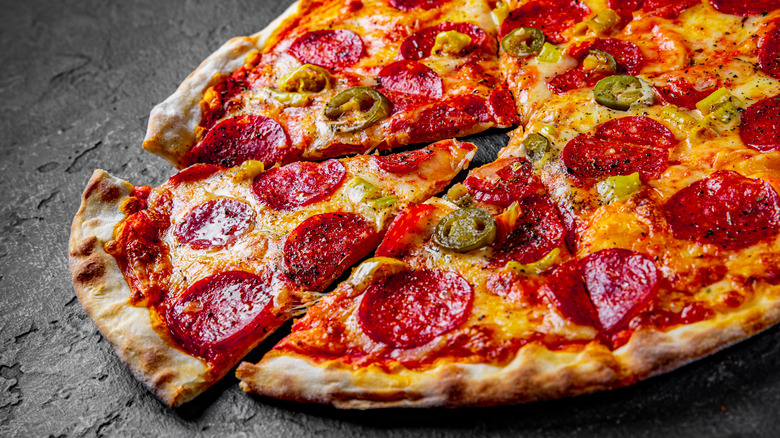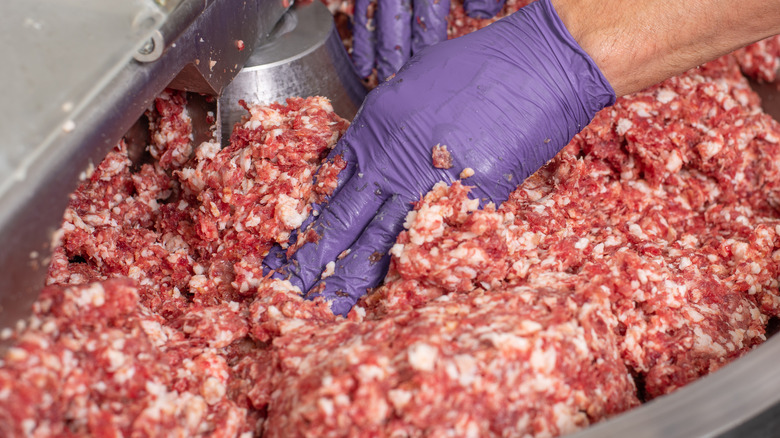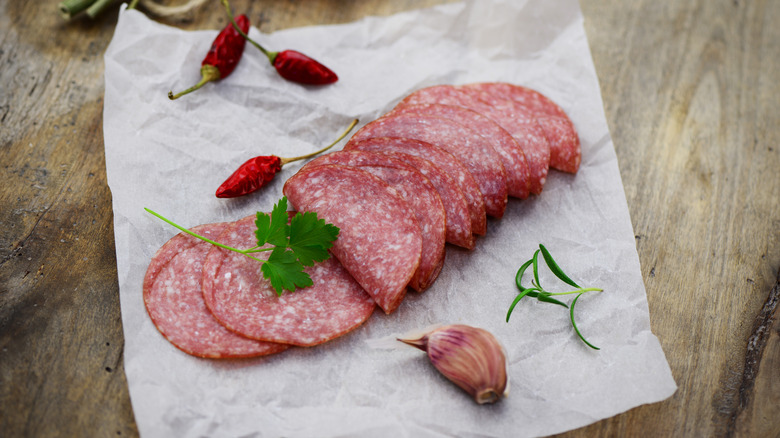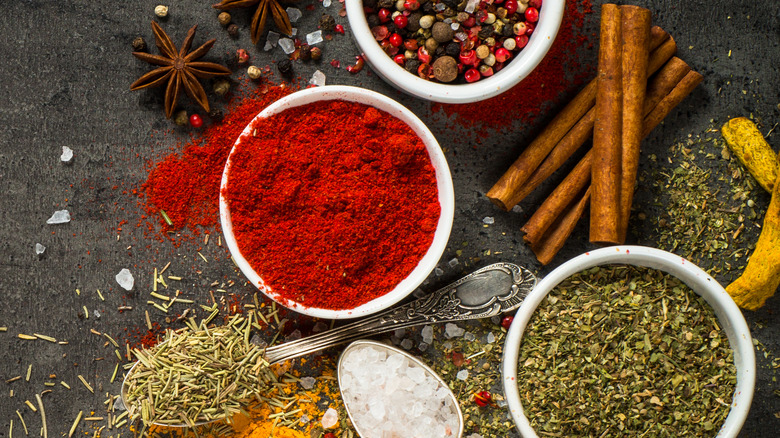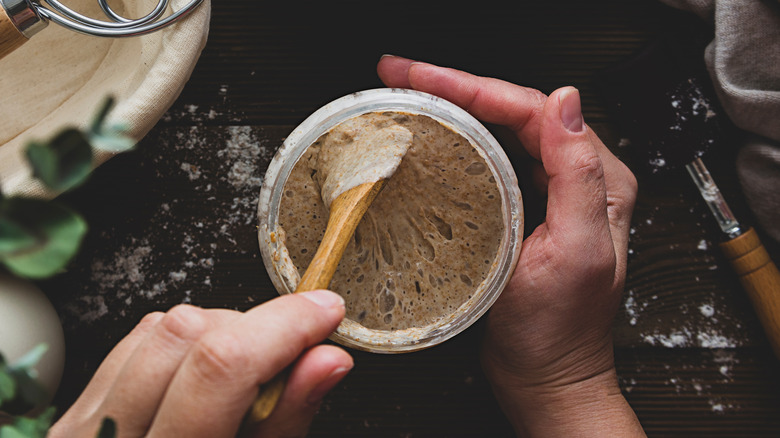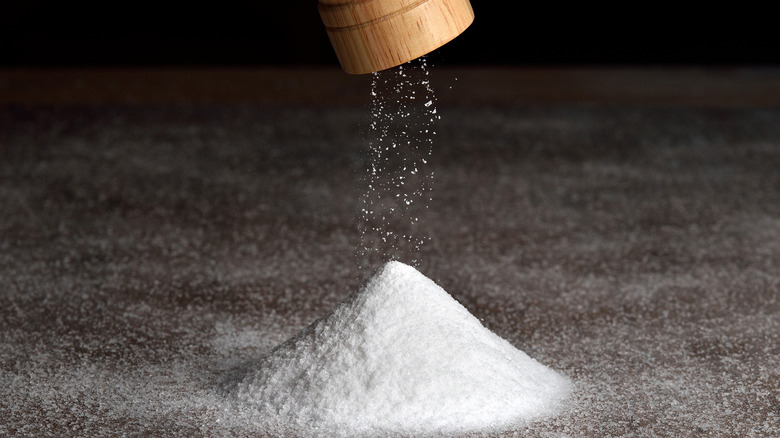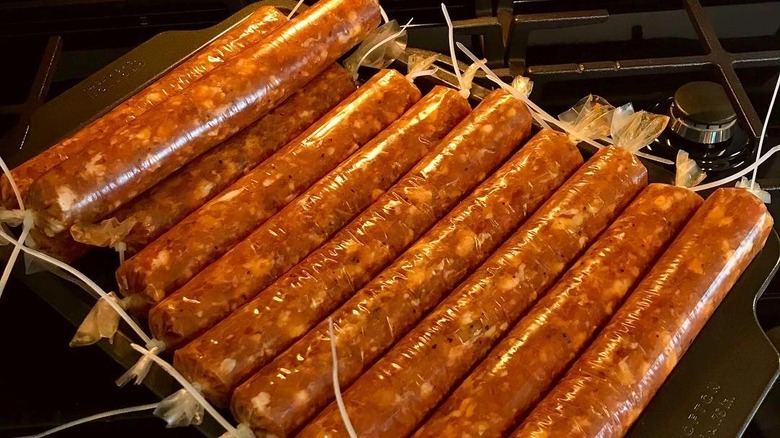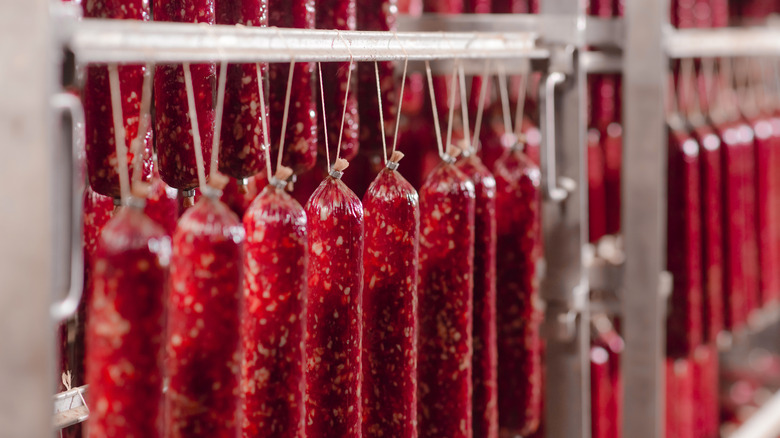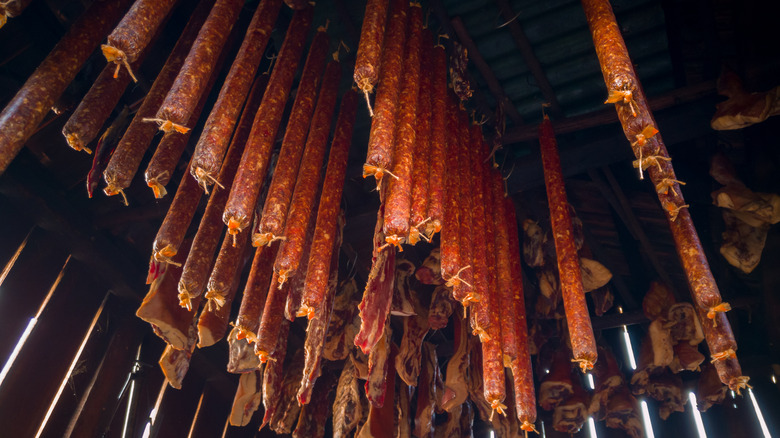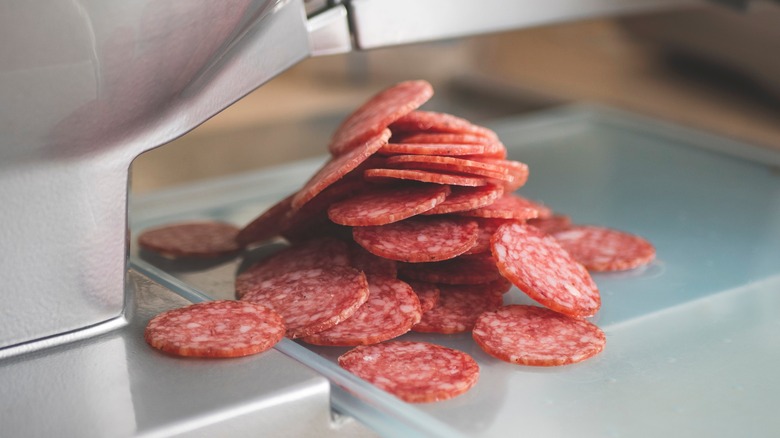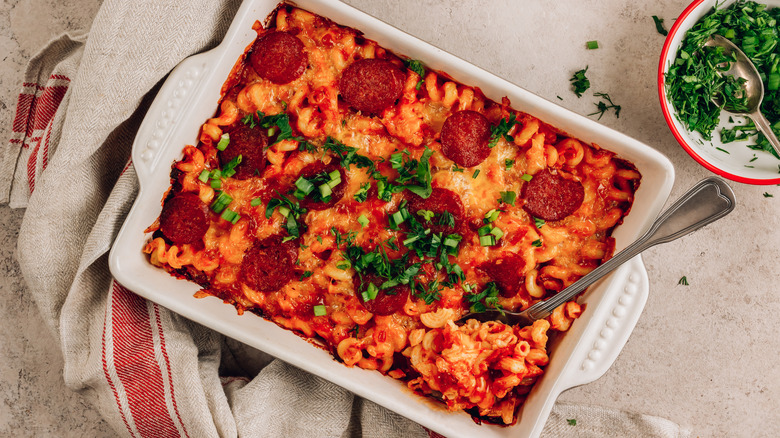This Is How Pepperoni Is Really Made
When it comes to pizza toppings, pepperoni reigns supreme. That's not just our belief but the opinion of the people: Ohio-based pizza chain Donatos commissioned a survey in January 2022 and found that pepperoni was the number one most popular topping to adorn a hot, cheesy slice (the least popular, in case you're wondering, were anchovies, pineapple, and jalapeños).
Given that same survey found the love of pizza runs deep (around a third of respondents were willing to spoil the ending of every movie they saw over the next year or shave their entire body, eyebrows included, for a year's worth of free pizza), we decided to dive a little deeper into its most beloved companion.
Pepperoni is a type of spicy smoky salami that first appeared in Italian-American markets after World War I. Italian immigrants took their traditional salami recipes and tweaked them to fit ingredients more readily available in the United States. It actually took years after its origination for pepperoni to make its way onto pizza but once it did, the thin savory slices quickly became a quintessential part of the pizza-eating experience. So, now that we know how pepperoni got here, let's take a look at how it's made.
Pepperoni typically contains ground pork, beef, or both
Pepperoni is usually made with ground pork or a mix of ground pork and ground beef. While all-beef versions exist, they aren't quite as popular and you'll be able to spot them right away because, as Science Direct points out, they must be specifically labeled as beef pepperoni. That's in contrast to pepperoni made with pork, which doesn't require any special labeling — just plain old pepperoni will do. Occasionally, you'll also see pepperoni made with chicken or turkey, but a mix of ground pork and beef remains the most authentic combo, according to Tastessence.
One of the characteristics that distinguishes pepperoni from other types of salami is how finely the meat is ground before the rest of the ingredients are added. This results in a product with a noticeably softer texture. A short video by How It's Made notes that pepperoni makers like to use meat from the back, shoulder, and belly areas, and Taste of Artisan adds that pork butt and chuck roast are common cuts to choose from.
It has a very specific fat to protein ratio
According to the Meat Products Handbook, pepperoni must contain 30 to 35% fat to obtain the characteristic grain and texture that makes it a pizza staple. That's why cuts of meat that are 70% lean and 30% fat are common to start with. But it's not just the amount of fat that matters, it's the type of fat too. The majority should be hard fat (from the shoulder, back, etc.), while softer fat (like that from the belly) should be limited so the texture is balanced — soft, but not too soft to hold its shape.
While the high-fat content is part of what makes pepperoni so good, The Spruce Eats warns that it is also responsible for spoilage as fat can turn rancid over time if exposed to oxygen, heat, or light. That's why Angie Rito, co-author of the cookbook "Italian American" and one of the two chef-owners behind Don Angie, a Michelin starred Italian-American restaurant in New York, told Bon Appétit she recommends buying pepperoni in one piece or stick with the casing intact rather than buying it pre-sliced. That's because "when you get the pre-sliced stuff, it's already starting to oxidize." So, while pre-sliced is easier, you should buy your pepperoni in one piece and slice it yourself for the freshest flavor. If you can't find it in your local supermarket aisles, try asking at the deli counter for a whole, half, or quarter stick.
The most dominant spice is usually paprika
Per Taste of Artisan, the dominant spice in pepperoni is paprika. Rito also gave Bon Appétit some insight into how that came to be, explaining that pepperoni seems to be inspired by an authentic Italian "Neapolitan- or Calabrese-style dried salami that would have a lot of dried chiles in it." That makes sense given that the first Italian immigrants mainly arrived from these southern regions. Dried chiles wouldn't have been as accessible to early Italian-American butchers as they were in their homeland, but paprika was easy to acquire. So, they adjusted their traditional recipes and pepperoni hit the scene.
Since recipes vary from place to place, brand to brand, and chef to chef, other aromatic spices like anise, allspice, fennel, nutmeg, cinnamon, cloves, mustard, cayenne pepper, black pepper, and sometimes a little sugar can be used in pepperoni. Together, these spices give it a complex, savory, smoky flavor that's hard to get anywhere else.
You'll find the same kind of bacteria as in sourdough bread
The Spruce Eats explains how lactic acid bacteria — the same kind of bacteria that Healthline notes is used to make certain varieties of cheese, sourdough bread, wine, and other foods we love — is added to pepperoni to trigger a fermentation process that produces lactic acid (hence the bacteria's name). Lactic acid is crucial for perfect pepperoni because it lowers the pH of the meat. This not only helps prevent the growth of harmful bacteria that can't survive in acidic environments (via Cravings of a Food Scientist), but it also produces pepperoni's signature tangy taste.
This approach to food safety is nothing new. But, while fermentation has been used to preserve foods for thousands of years, it wasn't until the mid-1800s that we really understood what was going on. That breakthrough was thanks to a French chemist named Louis Pasteur, who according to Living History Farms, originally described the process of fermentation as "respiration without air." If the name Pasteur sounds familiar, it's because he also invented pasteurization, the process of heating food to kill harmful bacteria (via Britannica).
Salt is used to cure pepperoni
The next step in the pepperoni-making process also has to do with preservation and flavor. According to History, Egyptians were the first to discover that salt could be used to preserve meat. The Spruce Eats details how two types of salt — sodium chloride, aka table salt, and sodium nitrate — are mixed into pepperoni meat to draw out moisture and make it inhospitable to bacteria that can cause spoilage. Meat preserved this way is called cured meat and can be stored for long periods of time without refrigeration.
Per The Spruce Eats, as sodium nitrate cures meat, it becomes transformed into sodium nitrite. While research described by Live Science suggests nitrites aren't inherently bad for you, it doesn't mean you should eat pepperoni every single day. The outlet indicates that eating too much processed meat has been linked to certain types of cancer, so there are likely other factors at play. As with many foods, it's all about moderation, so absolutely enjoy pepperoni, just try to do so within reasonable limits.
You can also opt for nitrate-free or uncured, pepperoni. Just know that it might not have the bright red color you're used to seeing because, as Mental Itch points out, the reaction of sodium nitrate with a meat-based molecule gives pepperoni its characteristic color.
Ground meat is packed into natural or artificial casings
Once the ground meat is mixed with spices, lactic acid bacteria, and the necessary salts, it's stuffed into casings around an inch in diameter and twisted at regular intervals to form individual sticks of pepperoni ready to be dried and smoked.
Either natural or artificial casings can be used. According to The Spruce Eats, natural casing has been used to make sausage for centuries and it is simply intestine from a variety of farm animals including cattle, pig, goat, or sheep. Artificial casing, on the other hand, is man-made using collagen or cellulose. While artificial collagen casings are typically edible, cellulose casings should be peeled off before eating.
Both types of casings have their benefits, and the one you (or pepperoni manufacturers) will prefer all depends on what you're looking for in the final product. If you want a natural and artisanal pepperoni that crisps and curls around the edges, then natural casing is best. But if ease of use and uniformity in size, shape, and weight is a higher priority, artificial is often better suited.
Handmade or machine-made products are sold
Dedicated home chefs can make pepperoni in their very own kitchens, but let's start with the production on a mass scale. How it's Made explains that commercial pepperoni starts with an industrial-sized grinder that grinds up large cuts of meat to mix with spices, curing agents, and lactic acid bacteria. Next, the meat is transferred to a machine that funnels it into cylindrical tubes where the casing awaits, ready to be filled. The machine pumps the ground meat through the tubes to fill each length of casing with a specific amount. Then, the casing is twisted and sealed to create the individual identical sticks you see at the deli. The pepperoni is then fed onto a hanging line and rolled away to be dried and smoked.
Making homemade pepperoni is similar, just without the machines. Meat is mixed and stuffed into casing by hand (The Washington Post recommends using a simple funnel to make this process easier) or with a sausage stuffer (yes, that's the technical term) that's specifically made for home use. It also requires a curing agent; The Spruce Eats suggests using something like saltpeter. You don't have to add a lactic acid bacteria (The Cookful has a recipe that doesn't), but if you want that characteristically tangy taste, you can easily purchase it with your curing agent online.
Air-drying and smoking set pepperoni apart
One of pepperoni's defining characteristics is that it's air-dried and smoked, another process that contributes to its long shelf life and unique taste. On a commercial scale, pepperoni sticks are draped across a hanging rack and stored in a humidity-controlled room to dry in several phases over a period of five to six days, per Science Direct. The temperature starts around 77 degrees — not quite hot, but warm enough to trigger fermentation by the lactic acid bacteria. After about 48 hours, How it's Made notes that the temperature is briefly lowered to halt fermentation before cranking it up and applying smoke for several hours. After that, the pepperoni is left to continue drying between 122 to 131 degrees until it's at least 30% lighter in weight than when it started.
At home, pepperoni can hang for six to eight weeks in a cool dry space before it is adequately dried. Just like the big guys, you'll know it's done when the pepperoni's overall weight is significantly lighter than when you started. The Spruce Eats recommends shooting for a 35% to 40% reduction for homemade pepperoni. To get that savory smoky flavor, you can also smoke it on a grill, in a smoker, or in a literal smokehouse if you just so happen to have one.
It's made to be sliced thin ... but not too thin
Nobody wants thick slabs of pepperoni that don't crisp as they cook, but pepperoni that's too thin can be equally disastrous. Serious Eats experimented with pepperoni thickness and found the thinnest slice (about 0.05 inches) completely disappeared beneath the cheese, never even having the chance to crisp. The sweet spot, at least in order for pepperoni to curl around the edges and crisp up, seems to be between 0.1 to 0.25 inches.
The thicker the slice, the larger the difference in how fast it cooks on the bottom vs the top. That difference in heating and cooking rate could help the edges of the pepperoni curl. But make the slices too thick, and they won't end up cooking through at all. And remember, if you're cooking at home and crispy little pepperoni bowls are your jam (in case you missed it, The Wall Street Journal reported on a hot debate between people who think pepperoni should curl up as it cooks and people who think it should lay flat), look for pepperoni with natural casing.
Pizza isn't the only use for pepperoni
Regardless of how you like your pepperoni to perform, it has a tangy, savory flavor that can add complexity and smokiness to a wide variety of dishes — so trust us when we say it's worth exploring pepperoni recipes outside of pizza.
Starting with pizza-inspired recipes like pepperoni pizza casserole, one-pot pizza rigatoni, and pizza bagels using a pepperoni hack that's so simple but effective it will blow your mind, there are dozens of options to explore. And, you don't always have to use whole pepperoni slices. In fact, Rito and her co-author and co-owner Scott Tacinelli also told Bon Appétit that they like to render the fat out of pepperoni by running it back through a meat grinder (or food processor) and using the vibrantly colored oil to add a pop of flavor and color to rice, ragùs, homemade breadcrumbs, and more. Since you can eat pepperoni raw (thanks to its curing and drying process), it makes a tasty complement to other meats and cheeses on a charcuterie board.
Meatless pepperoni is great for vegetarians
We'd be remiss if we didn't mention vegan pepperoni. Remember Donatos, the pizza chain whose survey crowned pepperoni king in January 2022? It introduced a vegan pepperoni pizza that very same month. As part of a partnership with plant-based meat and cheese company Field Roast (the same company that supplies Little Caesars' vegan pepperoni), the meatless substitute is made with pea, potato, and fava bean proteins mixed with garlic, black pepper, fennel, anise, cayenne, and paprika.
We obviously had to try it for ourselves, and have to say it doesn't taste too far off from the real thing. The pepperoni was piled on in massive quantities along with the cheese and crust from their signature Columbus-style pizza. All in all, it worked fairly well.
That said, it's definitely earthier in flavor and chewier in texture than its counterpart. As big fans of the distinctively crispy greasy element that traditional pepperoni provides, we were left a little wanting. Nonetheless, it's a solid option for anyone who wants some of the traditional pizza experience while following a completely plant-based diet (though if that's your goal, you'll want to order your pizza with vegan cheese and a vegan crust too).
